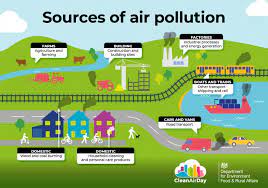- Different types of outdoor air pollutants
- Sources of air pollution
- Outdoor air pollutants and their sources
- Ozone and particulate matter
- Current pollution levels
- Air pollution and climate change
Different types of outdoor air pollutants
Air pollution is changeable and there are many different air pollutants contributing to it. Once pollutants are released into the air, they interact with each other and the environment in complex ways depending on temperature, humidity and other environmental conditions.
Pollutants can be categorised into two groups:
• Primary pollutants – which come from human processes
• Secondary pollutants – which are from the interaction of primary pollutants with the atmosphere
Sources of air pollution
Human activities are the main sources of air pollution. Using energy in our homes, industrial activities, transport and farming are the main actions that have been directly linked to emissions.
 |
|
Outdoor air pollutants and their sources
Ozone and particulate matter
The main pollutants scientists focus their research on are ozone and particulate matter as they present the most widespread health threats.
Ozone
Ozone is an odourless, colourless gas that occurs both in the Earth’s upper atmosphere (stratosphere) and at ground level (troposphere). The ozone found in the troposphere is a major public health concern.
Concentrations of ozone are higher in the summer and in the afternoon, as it is formed during sunlight. The highest daily peaks typically occur during hot, dry periods in the summer.
Particulate matter
Particulate matter is a mixture of solid bits and liquid droplets floating in the air. It includes particles from: dust, soil, materials from roads, farming, mining, windstorms or volcanoes, stone quarries, as well as sea salts, pollen, mould, spores and other biological material.
Fine particles are a sub-group of particulate matter and come from the direct emissions from combustion processes such as gasoline and diesel use in vehicles, wood burning, coal burning for power stations and industrial processes such as smelters, cement, plants paper mills and steel mills.
All types of particulate matter are linked with ill health.
Current pollution levels
The European Environment Agency provides a range of information on the enviroment including interactive maps about current levels of pollution:
- View current ground level ozone across Europe
- View the levels of different pollutants in different years
- See how your country currently compares to the EU standards
Air pollution and climate change
A number of processes that contribute to air pollution, such as burning fossil fuels, also contribute to an excess amount of greenhouse gases in the environment, which leads to global warming.
By reducing the amount of fossil fuels we use worldwide, we could help to combat air pollution levels as well as global warming.
